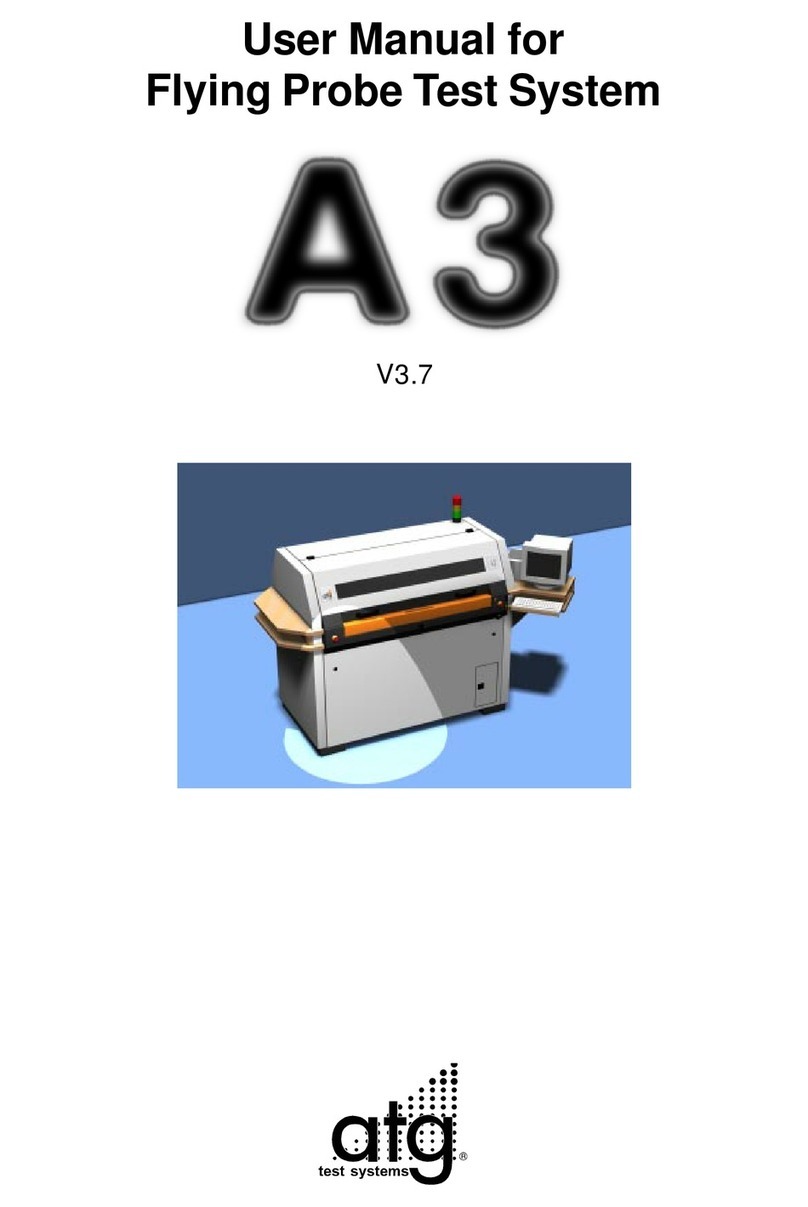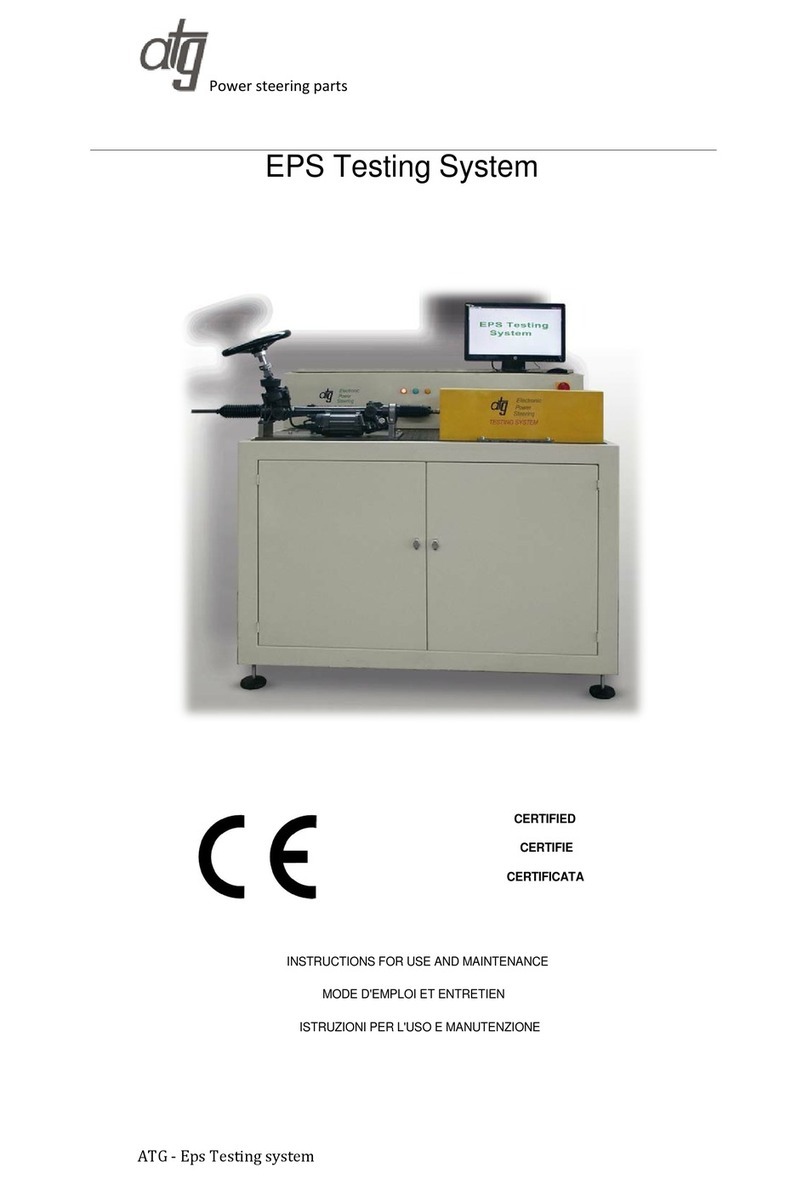
Powersteeringparts
ATG‐HydraulicTestingsystem
following results (value of 3 dB uncertain).
The surface sound pressure level Lp.
- Lp ˂70dB(A) during operation
The sound power level Lw.
- Lw ˂70dB(A) during operation
The frequency root mean RMS weighed for hand-arm
acceleration does not exceed 2.5m/s².
The measurements are taken in accordance
with standards UNI7712, ISO3740, ISO 3746 and
EC/2006/42.
The emission levels indicated are not necessarily safety
levels. Although there is a relationship between the
emissions and exposure levels, the values shown cannot
be used for establishing the need for further precautions.
There are other factors which influence the exposure
levels of operators, such as the features of the work place,
presence of other sources of noise, number of machines
running, etc.
The exposure levels may also vary between countries.
This information is necessary for the user for better
evaluation of the risks and hazards deriving from noise.
1.8 INFORMATION ABOUT ELECTROMAGNETIC
COMPATIBILITY
The european regulations on safety and in particular
the EEC directive 2004/108 contemplate that all the
equipment be equipped with shielding devices against
radio interferences both from and towards the outside.
This machine is equipped with filters both on the motor
and on the power supply through which the machine is
safe and in compliance with above regulations.
Tests were carried out according to 61000-6-1, EN
61000-6-3, EN 55014-1, EN 55014-2 regulations.
1.9 Machine Description (Fig. 1 )
The machine consists of a machine body D complete with
brake F and gear. In front of the machine there are two
gauges C, two flowmeters E, a temperature gauge F, a
display G, a spindle H, a security guard I and an indication
of the oil level in the tank L. There is also a motor M and
the selection of what test is performed through handles N.
A Beam
B Brake
C Gauges
D Body machine
E Flowmeters
F Temperature gauge
G Display
H Spindle
I Security guard
L Indication of the oil level in the tank
M Motor
N Handles
HYDRAULIC VERSION
WEIGHT:.................................................... .700 Kg.
SIZE: ..................................... cm 1660x850 x H 1770
PACKAGING SIZE:…………………… cm 1770X 1240 XH
1800
2 INSTALLATION
2.1 REMOVING THE PACKING
The machine is delivered inside a box suitable for the
purpose.
Therefore, the packing must be removed completely by
means of suitable tools and care must be take in order to
avoid damage to any part of the machine.
For packing disposal, please refer to 6.4 point.
2.2 HANDLING AND TRANSPORTION (Fig. 2)
The machine and must be moved only using suitable lifting
devices.
WARNING: Do not try to move or lift the
machine by hand even if more people are
present.
WARNING: The operations described in this
manual relative to sling, transport and lifting
by means of a fork lift or hoist must be carried
out only by skilled and qualified personnel
(EC/2006/42).
Move the machine carefully and avoid sudden movements
which could unbalance the load and make it drop.
To remove the machine from the plate after packing removal,
loosen the fixing screws but keep them should the machine
be transported for long stretches.
To move the machine while it is still inside the packing, use
a fork lift by inserting the two forks in the rooms provided
under machine.
2.3 ELECTRICAL CONNECTIONS
Check that the mains to which the machine is connected is
earthed in accordance with current safety regulations and
that the power point is in good condition.
Connect a plug in compliance with safety rules to the
end of the mains cable of the machine, checking that the
yellow/green protective conductor is fitted into the relative
terminal marked.
Remember that there should be a magnetothermic
protective device fitted upstream of the mains to protect all
the conductors from short circuits and overloads.
This protective device should be selected according to the
electrical features of the machine stated on the motor.
The motor of your machine is equipped with a protective
heat circuit breaker which interrupts the power supply
when the temperature of the coils rises too high.
When the power supply is interrupted, wait for normal
reset.
UNIVERSAL VERSION
In case of power failure in mains, while you wait for power
to be restored there is no danger hazard may arise : in
fact, the electronic speed variator is also equipped with a
reset function which prevents the machine from re-starting
automatically. To start the machine, press the start push
button A again.
WARNING: Never change setting to avoid
overloads which could damage the electric
circuits and other mechanical members.
Your machine is equipped with a motor protection
obtained through a amperometric limiter which prevents
the motor from absorbing a current higher than the set





























